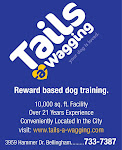Reactivity in dogs is described as barking,
lunging, growling, snapping and generalized vocalizing towards a trigger. A trigger might be a person, a dog, a cat a
bike or anything that causes stress to your dog.
Dogs show reactive behavior to either make the
“trigger” come closer or go further away.
You can determine which is the situation for your dog based on your
dogs’ body language. (See body language handout)
In understanding reactivity in dogs, we need to first
understand that dogs exhibit a behavior because they get a benefit from
it. By determining the benefit, you may
be able to assist your dog in reducing their reactive behavior.
The most common reason for reactivity is our dog’s
own self-confidence or lack thereof.
Lack of proper socialization at a young age is also part of the
equation. Knowing we, as their
guardians, are ones to be trusted by offering predictable leadership behaviors
to them is key.
Working with a reward-based trainer, one who specializes
in reactivity in dogs is essential.
This trainer needs to have extensive training in reading body language
and controlling stressed based impulse behaviors.
Here are things you can do, right now, to help your
dog.
Remove all pressure from your dog’s neck when
walking them.
Choke
chains, pinch collars and other neck restrictive collars can actually create
reactivity in dogs. One
of the first and most important things we can easily do to help a dog feel more
secure is to remove pressure from the dog's neck. Even the slightest pressure
on the neck restricts breathing. In the moment of a fearful or anxious
encounter (and this can include just looking at another dog or person), a
sensation of choking or not being able to breathe only heightens the anxiety.
In addition, one leash contact to a collar on the neck is not the most
effective way to rebalance a dog that is pulling, straining, or leaning
forward. The use of a Gentle Leader with a second point of contact on a harness
removes the possibility of constant tension on the neck and helps us to bring
the dog back into a position of balance on all four feet. The Gentle Leader
also allows us to encourage the dog to avert his eyes or slightly turn his head
away from another dog (which is a calming signal to the other dog) with a very
small signal.
It is extremely important to know that choke
chains and pinch collars can also cause permanent damage to your dog’s trachea
and muscle structure. The purpose of
these types of collars are to give a physical correction to the dog when they
do the wrong thing (pull on leash, break a command etc.) the problem is that
physical correction can also instills a sense of fear in your dog. Since they cannot trust what they fear, corrections
can change the relationship we have with out dogs.
Relax
It is important that the handler not react to the dog's reactions. This
is not always easy if it is your own dog! Maintaining a calm, confident, and
neutral emotional state when working with a reactive dog can greatly influence
the dog's emotional state. Releasing tension from your body and being aware of
your own balanced/neutral pelvis position makes you much more effective in the
event the dog does react or suddenly pulls you toward the other dog.
Know your dog
There
is a distance your dog can be from the trigger at which they do not react. This may be a football field, but there is a
distance at which they are not showing signs of stress. Keep this distance constant when you encounter
a trigger. If you are walking your dog
and your dog is reactive towards other dogs and you see a person/dog team
approaching, say nothing and quickly turn and go in the other direction. This shows your dog you have taken control of
the situation. Reward your dog when they
are calm and relaxed. You may need to
walk your dog early in the morning or late at night to minimize the triggers.
Do not react to
your dogs reactivity
If
your dog goes off on a trigger and you reprimand, yell, tug, pull or otherwise
react to your dogs behavior, you are feeding the problem. Prevention is your best tool, until you can
work with a trainer to learn behavior modification to reduce and eliminate the
issue.
Our Getting to Calm Class is a great option for Reactive Dogs


Thanks for taking the time to discuss this. I feel strongly about it and love learning more on this topic. If possible, as you gain expertise, would you mind updating your blog with more information? It is extremely helpful for me. Thanks!
ReplyDeletethanks so much for everything you’ve put into it this blog has me coming back time and time again. I will pass it to our friends. Thanks again,Training Your Dog
ReplyDelete